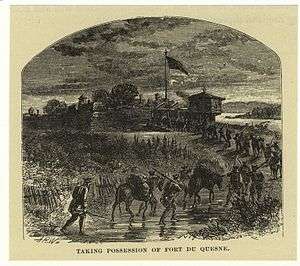Forbes Expedition
The Forbes Expedition was a British military expedition led by Brigadier-General John Forbes in 1758, during the French and Indian War.

Objective
Like the unsuccessful Braddock Expedition early in the war, the strategic objective was the capture of Fort Duquesne, a French fort constructed at the confluence of the Allegheny and Monongahela Rivers in 1754 (site of present-day downtown Pittsburgh, Pennsylvania's Golden Triangle).
Order of Battle
Forbes commanded about 6,000 men, including a contingent of Virginians led by George Washington. Forbes, very ill, did not keep up with the advance of his army, but entrusted it to his second in command, Lt. Col. Henry Bouquet, a Swiss officer commanding a battalion of the Royal American Regiment.
| Unit | Strength |
|---|---|
| Division of 1st Battalion, Royal Americans | 363 |
| Highland, or 62nd Foot | 998 |
| Division of 62nd Foot | 269 |
| 1st Virginia Regiment | 782 |
| 2nd Virginia Regiment | 702 |
| Three companies of North Carolina Provincials | 141 |
| Four companies of Maryland Provincials | 270 |
| 1st Battalion, Pennsylvania Regiment | 755 |
| 2nd Battalion, Pennsylvania Regiment | 664 |
| 3rd Battalion, Pennsylvania Regiment | 771 |
| Lower County Provincials | 263 |
| Source: | [1][2] |
Forbes' Road
The expedition methodically constructed a road across what is now the southern part of Pennsylvania's Appalachian Plateau region, staging from Carlisle and exploiting the climb up via one of the few southern gaps of the Allegheny through the Allegheny Front, into the disputed territory of the Ohio Country, which was then a largely depopulated Amerindian tributary territory of the Iroquois Confederation.[lower-alpha 1] This well organized expedition was in contrast to a similar expedition led by Edward Braddock in 1755 that ended in the disastrous Battle of the Monongahela.
Advance
Working for most of the summer on the construction of the road and on periodic fortified supply depots, the expedition did not come within striking distance of Fort Duquesne until September 1758. In mid-September, a reconnaissance force was soundly defeated in the Battle of Fort Duquesne when its leader, Major James Grant, attempted to capture the fort instead of gathering information alone. The French, their supply line from Montreal cut by other British actions, attacked one of the expedition's forward outposts, Fort Ligonier, in an attempt to either drive off the British or acquire further supplies, but were repulsed in the Battle of Fort Ligonier.
French Strategic Collapse
The Treaty of Easton concluded on October 26, 1758, caused the remnants[lower-alpha 2] of the Lenape (Delaware), Mingo, and Shawnee tribes in the Ohio Valley to abandon the French, and set up the conditions that ultimately forced them to move westward once again. This collapse of Native American support made it impossible for the French to hold Fort Duquesne and the Ohio Valley. When the expedition neared to within a few miles of Fort Duquesne in mid-November, the French abandoned and blew up the fort. Three units of scouts led by Captain Hugh Waddell entered the smoking remnants of the fort under the orders of Colonel George Washington on November 24. General Forbes, who was ill with dysentery for much of the expedition, only briefly visited the ruins. He was returned to Philadelphia in a litter, and died not long afterward. The collapse of Indian support and subsequent withdrawal of the French from the Ohio Country helped contribute to the "year of wonders", the string of British 'miraculous' victories also known by the latin Annus Mirabilis.
See also
- Forbes Road
- Braddock Expedition
- Nemacolin's Path
- Beaver Wars
- Susquehannock peoples
- Erie peoples
- Shawnee
Notes
- The Iroquois, from the early 1610-20s began a decades long series of wars with other native peoples for control of the streams containing Beaver Pelts, called the Beaver Wars. While the Susquehannock long defeated the Iroquois, the tribe was all but wiped out by disease about 1670. The Erie, another with a range west of the Allegheny Mountains were similarly defeated by the Iroquois in the Beaver wars.
- By the middle 1670s (in the aftermath of the Beaver Wars) the Iroquois had conducted aggressive war on most all surrounding tribes south of the Great Lakes, pushing many other tribes into moving west or oblivion. The ravages of disease had generated great losses regardless of decades of relentless wars over hunting territories. By the time of the French and Indian War, the Iroquois weakened by the 1660s defeats by the Susquehannocks had absorbed other tribes and regained their strength. The remarkable unity of the Iroquois fled during the American Revolution, and the power of the Iroquois was a casualty of the war, opening up the Ohio Country for settlement, as all remaining eastern tribes of Amerindians were fairly weak by the 1880s.
Footnotes
- Lowdermilk 1878, p. 249.
- Sipe 1929, p. 387.
References
- Anderson, Fred (2000). Crucible of War: The Seven Years' War and the Fate of Empire in British North America, 1754–1766. New York: Alfred Knopf. ISBN 978-0-375-40642-3. OCLC 237426391.
- Cubbison, Douglas R (2010). The British Defeat of the French in Pennsylvania, 1758: A Military History of the Forbes Campaign Against Fort Duquesne. Jefferson, NC: McFarland. ISBN 978-0-7864-4739-8. OCLC 475664242.
- Fowler, William M (2005). Empires at war: The French and Indian War and the Struggle for North America 1754-1763. New York: Walker & Company. ISBN 0-8027-1411-0.
- Lowdermilk, Will H. (1878). History of Cumberland. Washington, DC.
- O'Meara, Walter (1965). Guns at the Forks. Englewood Cliffs, NJ: Prentice Hall. OCLC 21999143.
- Sipe, C. Hale (1929). The Indian Wars of Pennsylvania. Harrisburg.
External links
- Forbes Expedition (George Washington's Mount Vernon)
